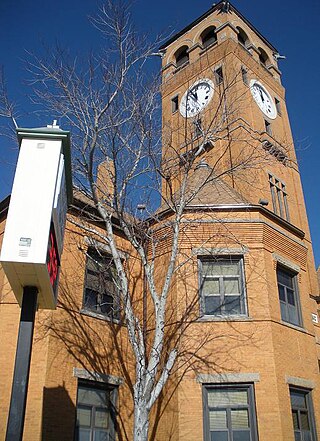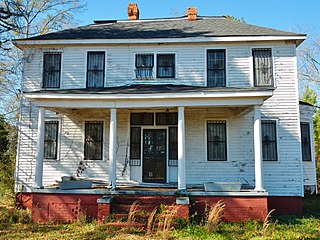Related Research Articles

Tuskegee is a city in Macon County, Alabama, United States. General Thomas Simpson Woodward, a Creek War veteran under Andrew Jackson, laid out the city and founded it in 1833. It became the county seat in the same year and it was incorporated in 1843. It is the most populous city in Macon County. At the 2020 census the population was 9,395, down from 9,865 in 2010 and 11,846 in 2000.

Altheimer is a city in Plum Bayou Township, Jefferson County, Arkansas, United States. It is situated on the Union Pacific Railway, 11 miles (18 km) northeast of Pine Bluff. As of the 2010 census it had a population of 984, down from 1,192 at the 2000 census. As of 2018 the estimated population was 829 and was down to 696 in the 2020 Census, with zero change estimated in 2021 and 2022.

Tuskegee University is a private, historically black land-grant university in Tuskegee, Alabama. It was founded on Independence Day in 1881 by the Alabama Legislature.

The University of Arkansas is a public land-grant research university in Fayetteville, Arkansas. It is the flagship campus of the University of Arkansas System. Founded as Arkansas Industrial University in 1871, classes were first held in 1872, with its present name adopted in 1899.

The University of Arkansas at Pine Bluff (UAPB) is a public historically black university in Pine Bluff, Arkansas. Founded in 1873, it is the second oldest public college or university in Arkansas. It was one of about 180 "normal schools" established by state governments in the 19th century to train teachers for the rapidly growing public common schools. It was one of 23 established to train African Americans to teach in segregated schools. Some of the 180 closed but most steadily expanded their role and became state colleges in the early 20th century and state universities in the late 20th century. UAPB is part of the University of Arkansas System and Thurgood Marshall College Fund.

Hampton University is a private, historically black, research university in Hampton, Virginia. Founded in 1868 as Hampton Agricultural and Industrial School, it was established by Black and White leaders of the American Missionary Association after the American Civil War to provide education to freedmen. The campus houses the Hampton University Museum, which is the oldest museum of the African diaspora in the United States and the oldest museum in the commonwealth of Virginia. First led by former Union General Samuel Chapman Armstrong, Hampton University's main campus is located on 314 acres in Hampton, Virginia, on the banks of the Hampton River.

Arkansas Tech University (ATU) is a public university in Russellville, Arkansas. The university offers programs at both baccalaureate and graduate levels in a range of fields. The Arkansas Tech University–Ozark Campus, a two-year satellite campus in the town of Ozark, primarily focuses on associate and certificate education.

The University of Arkansas at Monticello (UAM) is a public university in Monticello, Arkansas with Colleges of Technology in Crossett and McGehee. UAM is part of the University of Arkansas System and offers master's degrees, baccalaureate degrees, and associate degrees. The city is in the Arkansas Timberlands, and UAM is home to the state's only School of Forest Resources.

The Kentucky School for the Deaf (KSD), located in Danville, Kentucky, United States, is a school that provides education to deaf and hard-of-hearing children from elementary through high school levels. Founded in 1823, it was the first school for the deaf west of the Allegheny Mountains. Jacobs Hall, its oldest surviving building, was designated a National Historic Landmark in recognition of this history.

Arkansas Baptist College (ABC) is a private Baptist-affiliated historically black college in Little Rock, Arkansas. Founded in 1884 as the Minister's Institute, ABC was initially funded by the Colored Baptists of the State of Arkansas. It is the only historically black Baptist school west of the Mississippi River. The Main Building on its campus, built in 1893, is one of the oldest surviving academic buildings in the state, and was listed on the National Register of Historic Places in 1976.

The Calhoun Colored School (1892–1945), was a private boarding and day school for Black students in Calhoun, Lowndes County, Alabama, about 28 miles (45 km) southwest of the capital of Montgomery. It was founded in 1892 by Charlotte Thorn and Mabel Dillingham, from New England, in partnership with Booker T. Washington of Tuskegee Institute, to provide education to rural black students. African Americans comprised the majority in this area, and the state had segregated facilities. Calhoun Colored School was first designed to educate rural black students according to the industrial school model common at the time.
This is an incomplete list of historic properties and districts at United States colleges and universities that are listed on the National Register of Historic Places (NRHP). This includes National Historic Landmarks (NHLs) and other National Register of Historic Places listings. It includes listings at current and former educational institutions.
Dollarway School District No. 2 (DSD) was a school district headquartered in Pine Bluff, Arkansas, United States. With over 1,600 students and employing more than 300 educators and staff, the district had three active school campuses at the end of its life.

Western University (Kansas) (1865–1943) was a historically black college (HBCU) established in 1865 (after the Civil War) as the Quindaro Freedman's School at Quindaro, Kansas, United States. The earliest school for African Americans west of the Mississippi River, it was the only one to operate in the state of Kansas.
The University of Arkansas Campus Historic District is a historic district that was listed on the National Register of Historic Places on September 23, 2009. The district covers the historic core of the University of Arkansas campus, including 25 buildings.

The Street Manual Training School was a historic African American school in Richmond, Dallas County, Alabama. The campus comprised over 200 acres (81 ha), but most of it was sold after the school closed in 1971. The remaining 23.1-acre (9.3 ha) campus contains seven buildings constructed between 1906 and 1964 as well as a circa 1943 water tower. The school was listed on the National Register of Historic Places on July 28, 1999.

The Camp Crowder Gymnasium is a historic school building at 205 Shiloh Drive in Sulphur Springs, Benton County, Arkansas. It is primarily a building with local significance, and also is a rare example of military construction in the small community.
The Floyd B. Brown House is a historic house at 1401 South Georgia Street in Pine Bluff, Arkansas. It is a single-story vernacular brick structure, with a gable roof and brick foundation. Decorative elements on the building are minimal, with scalloped trim elements at the gables and eaves, and a fanlight in the front-facing gable. The house was built in 1954 for Floyd and Lillian Brown. The Browns were prominent African-American educators: Floyd Brown founded the Fargo Training School in Fargo, Arkansas, and his wife Lillian taught there.

Joseph Carter Corbin was a journalist and educator in the United States. Before the abolition of slavery, he was a journalist, teacher, and conductor on the Underground Railroad in Ohio and Kentucky. After the American Civil War, he moved to Arkansas where he served as superintendent of public schools from 1873 to 1874. He founded the predecessor of University of Arkansas at Pine Bluff and was its first principal from 1875 until 1902. He ended his career in education spending a decade as principal of Merrill High School in Pine Bluff. He also taught in Missouri.
Sergeant First Class Thomas Franklin Vaughns is an American veteran who was a member of the famed group of World War II-era African-Americans known as the Tuskegee Airmen. He is a recipient of the National Defense Service Medal in 2019, for his service in the Korean War. He is also a member of the Arkansas Agriculture Hall of Fame.
References
- ↑ "National Register Information System". National Register of Historic Places . National Park Service. July 9, 2010.
- ↑ "National Register Information System". National Register of Historic Places. National Park Service. Retrieved March 17, 2024.
- 1 2 3 4 5 "Floyd B. Brown (1891-1961)". Encyclopedia of Arkansas. Central Arkansas Library System (CALS).
- 1 2 3 4 Hill, Jack (Producer) (1994). Reporting for Arkansas: Work Will Win. Arkansas Public Broadcasting Service (PBS) and Special Collections at University of Arkansas Libraries. Retrieved March 16, 2024.
- ↑ "ARKANSAS A-Z: Fargo Agricultural School offered early boarding-school education for Black youth". Arkansas Democrat Gazette. November 25, 2023. Archived from the original on December 2, 2023.
- ↑ Schnedler, Jack (September 22, 2020). "ARKANSAS SIGHTSEEING: Black history center of Fargo museum". Northwest Arkansas Democrat Gazette. Archived from the original on March 17, 2024. Retrieved March 17, 2024.
- 1 2 3 4 5 6 7 8 9 10 11 12 "NRHP nomination for Fargo Training School Historic District" (PDF). Arkansas Preservation. Archived from the original (PDF) on June 13, 2015. Retrieved March 17, 2024.
- ↑ "The Board of Managers of the Arkansas Training School for Boys at Wrightsville et al., Appellants, v. Mrs. Nona Mae George et al., Appellees, 377 F.2d 228 (8th Cir. 1967)". Justia. Retrieved March 17, 2024.
- ↑ "Our Roots and Who We Are". Arkansas Land and Community Development Corporation (ALCDC).
- ↑ Crockett, Ashley (June 21, 2022). "Arkansas Land and Community Development Corporation to host farmers seminar". KATV (ABC television affiliate). Archived from the original on June 26, 2022. Retrieved March 17, 2024.